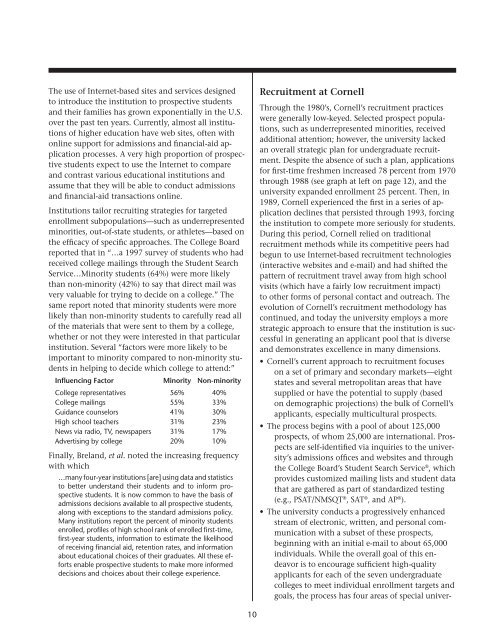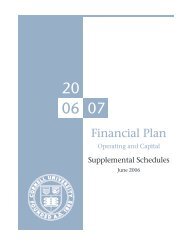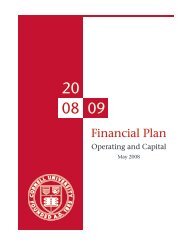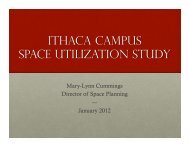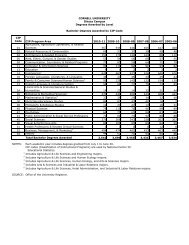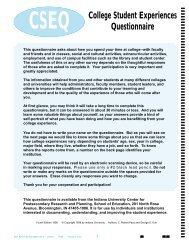Undergraduate Student Access - Cornell University Division of ...
Undergraduate Student Access - Cornell University Division of ...
Undergraduate Student Access - Cornell University Division of ...
You also want an ePaper? Increase the reach of your titles
YUMPU automatically turns print PDFs into web optimized ePapers that Google loves.
The use <strong>of</strong> Internet-based sites and services designedto introduce the institution to prospective studentsand their families has grown exponentially in the U.S.over the past ten years. Currently, almost all institutions<strong>of</strong> higher education have web sites, <strong>of</strong>ten withonline support for admissions and financial-aid applicationprocesses. A very high proportion <strong>of</strong> prospectivestudents expect to use the Internet to compareand contrast various educational institutions andassume that they will be able to conduct admissionsand financial-aid transactions online.Institutions tailor recruiting strategies for targetedenrollment subpopulations—such as underrepresentedminorities, out-<strong>of</strong>-state students, or athletes—based onthe efficacy <strong>of</strong> specific approaches. The College Boardreported that in “…a 1997 survey <strong>of</strong> students who hadreceived college mailings through the <strong>Student</strong> SearchService…Minority students (64%) were more likelythan non-minority (42%) to say that direct mail wasvery valuable for trying to decide on a college.” Thesame report noted that minority students were morelikely than non-minority students to carefully read all<strong>of</strong> the materials that were sent to them by a college,whether or not they were interested in that particularinstitution. Several “factors were more likely to beimportant to minority compared to non-minority studentsin helping to decide which college to attend:”Influencing FactorMinority Non-minorityCollege representatives 56% 40%College mailings 55% 33%Guidance counselors 41% 30%High school teachers 31% 23%News via radio, TV, newspapers 31% 17%Advertising by college 20% 10%Finally, Breland, et al. noted the increasing frequencywith which…many four-year institutions [are] using data and statisticsto better understand their students and to inform prospectivestudents. It is now common to have the basis <strong>of</strong>admissions decisions available to all prospective students,along with exceptions to the standard admissions policy.Many institutions report the percent <strong>of</strong> minority studentsenrolled, pr<strong>of</strong>iles <strong>of</strong> high school rank <strong>of</strong> enrolled first-time,first-year students, information to estimate the likelihood<strong>of</strong> receiving financial aid, retention rates, and informationabout educational choices <strong>of</strong> their graduates. All these effortsenable prospective students to make more informeddecisions and choices about their college experience.Recruitment at <strong>Cornell</strong>Through the 1980’s, <strong>Cornell</strong>’s recruitment practiceswere generally low-keyed. Selected prospect populations,such as underrepresented minorities, receivedadditional attention; however, the university lackedan overall strategic plan for undergraduate recruitment.Despite the absence <strong>of</strong> such a plan, applicationsfor first-time freshmen increased 78 percent from 1970through 1988 (see graph at left on page 12), and theuniversity expanded enrollment 25 percent. Then, in1989, <strong>Cornell</strong> experienced the first in a series <strong>of</strong> applicationdeclines that persisted through 1993, forcingthe institution to compete more seriously for students.During this period, <strong>Cornell</strong> relied on traditionalrecruitment methods while its competitive peers hadbegun to use Internet-based recruitment technologies(interactive websites and e-mail) and had shifted thepattern <strong>of</strong> recruitment travel away from high schoolvisits (which have a fairly low recruitment impact)to other forms <strong>of</strong> personal contact and outreach. Theevolution <strong>of</strong> <strong>Cornell</strong>’s recruitment methodology hascontinued, and today the university employs a morestrategic approach to ensure that the institution is successfulin generating an applicant pool that is diverseand demonstrates excellence in many dimensions.• <strong>Cornell</strong>’s current approach to recruitment focuseson a set <strong>of</strong> primary and secondary markets—eightstates and several metropolitan areas that havesupplied or have the potential to supply (basedon demographic projections) the bulk <strong>of</strong> <strong>Cornell</strong>’sapplicants, especially multicultural prospects.• The process begins with a pool <strong>of</strong> about 125,000prospects, <strong>of</strong> whom 25,000 are international. Prospectsare self-identified via inquiries to the university’sadmissions <strong>of</strong>fices and websites and throughthe College Board’s <strong>Student</strong> Search Service ® , whichprovides customized mailing lists and student datathat are gathered as part <strong>of</strong> standardized testing(e.g., PSAT/NMSQT ® , SAT ® , and AP ® ).• The university conducts a progressively enhancedstream <strong>of</strong> electronic, written, and personal communicationwith a subset <strong>of</strong> these prospects,beginning with an initial e-mail to about 65,000individuals. While the overall goal <strong>of</strong> this endeavoris to encourage sufficient high-qualityapplicants for each <strong>of</strong> the seven undergraduatecolleges to meet individual enrollment targets andgoals, the process has four areas <strong>of</strong> special univer-10


